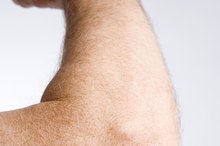Tile Layers and Knee Problems
Individuals who spend a lot of time on their knees -- including tile layers -- are likely to experience swelling in the front portion of their knees. This is the result of constant friction from sliding across the floor and maneuvering around on the knees. This condition is known as prepatellar bursitis 2. Prepatellar bursitis can make it difficult for a tile layer to easily complete his job.
If you are experiencing serious medical symptoms, seek emergency treatment immediately.
Prepatellar Bursitis
Prepatellar bursitis is also referred to as kneecap bursitis and affects the front portion of the kneecap 2. Continuous pressure on the kneecap can irritate a small sac known as the bursa. The bursa acts as lubrication when you move your knee. This allows for smooth, pain-free movements. When a tile layer is constantly moving around on his knees, the bursa can become inflamed. An inflamed bursa does not allow the knee to function as smoothly as it should.
- Prepatellar bursitis is also referred to as kneecap bursitis and affects the front portion of the kneecap 2.
- An inflamed bursa does not allow the knee to function as smoothly as it should.
Symptoms
Pain From a Torn LCL Ligament When Walking
Learn More
If you have prepatellar bursitis, you are likely to experience more pain while you are laying tiles or participating in any other form of physical activity. This pain will likely subside when work is over for the day and you are at home resting. You may also notice rapid swelling in the front portion of the knee while working. Your knee may also be tender or feel warm to the touch.
- If you have prepatellar bursitis, you are likely to experience more pain while you are laying tiles or participating in any other form of physical activity.
- You may also notice rapid swelling in the front portion of the knee while working.
Diagnosis and Treatment
If you experience persistent knee pain or swelling, you should contact your doctor. Your doctor is likely to take an x-ray to rule out further damage to the knee. Prepatellar bursitis can be diagnosed through a physical examination. This condition is treated conservatively. Treatment includes resting the affected knee and applying ice to it -- three to four times per day for no more than 20 minutes at a time. You should also try to keep your leg elevated as much as possible. Your doctor may prescribe anti-inflammatory medications in order to help relieve the pain. If the pain and swelling persist, your doctor may opt to drain the bursa with a needle. If the pain and swelling become chronic, surgery can be performed to remove the bursa.
- If you experience persistent knee pain or swelling, you should contact your doctor.
- If the pain and swelling persist, your doctor may opt to drain the bursa with a needle.
Prevention
How to Treat Bursitis in the Arm
Learn More
As a tile layer, the best way to prevent prepatellar bursitis is to wear knee pads. Knee pads can provide an extra layer of padding between you and the floor which can help reduce the friction that occurs in your knees. You should also try to get up and move around in between jobs in order to stretch your legs.
Related Articles
References
- Florida Orthopaedic Institute Sports Medicine: Anterior Knee Pain Syndrome
- American Academy of Orthopaedic Surgeons: Prepatellar Bursitis
- Baumbach SF, Lobo CM, Badyine I, Mutschler W, Kanz KG. Prepatellar and olecranon bursitis: literature review and development of a treatment algorithm. Arch Orthop Trauma Surg. 2014;134(3):359-70. doi:10.1007/s00402-013-1882-7
- Prepatellar (Kneecap) Bursitis, American Academy of Orthopaedic Surgeons, March 2014.
- Parker CH, Leggit JC. Novel Treatment of Prepatellar Bursitis. Mil Med. 2018;183(11-12):e768-e770. doi:10.1093/milmed/usy098
- Aaron DL, et al. "Four Common Types of Bursitis: Diagnosis and Management" J Am Acad Orthop Surg June 2011; 19:359-367.
- Huang YC, Yeh WL. Endoscopic treatment of prepatellar bursitis. Int Orthop. 2011;35(3):355-8. doi:10.1007/s00264-010-1033-5
Writer Bio
Michelle Zehr started writing professionally in 2009. She has written on health, fitness, fashion, interior design, home decorating,sports and finance for several websites. Zehr possesses a Bachelor of Arts in communication from the University of Pittsburgh, a Master of Arts in professional writing from Chatham University and a graduate certificate in health promotion from California University of Pennsylvania.







